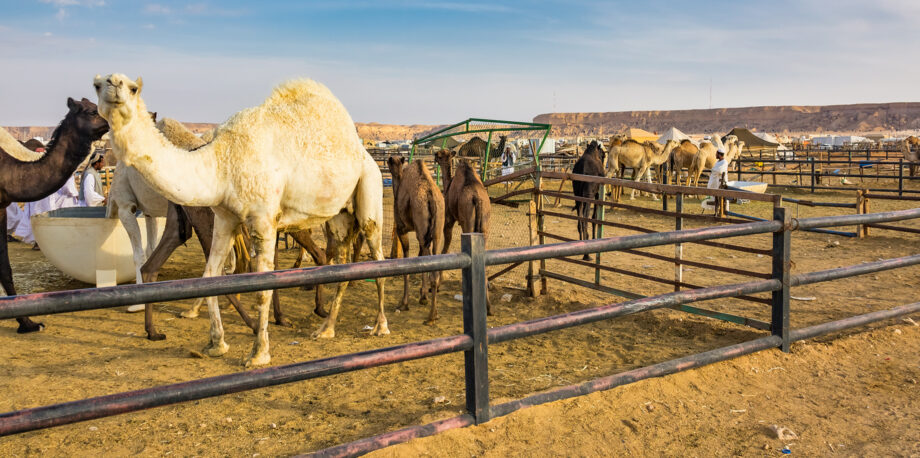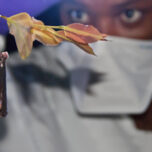May 12, 2020 — In November 2013, a previously healthy retired Saudi soldier was admitted to the intensive care unit of the King Abdulaziz University Hospital in Jeddah with a fever and severe shortness of breath. Five days later, his daughter started to show signs of respiratory illness. Two weeks later he died.
Researchers were quick to identify the cause. The 43-year-old man had been breeding nine dromedary camels in a shed, and a nose swab showed that he and one of his animals were infected with a recently identified, highly pathogenic coronavirus called Middle East Respiratory Syndrome, or MERS-CoV.
Alarm bells rang when it was found that MERS could be transmitted both from camels to humans and from humans to humans. Was this the mysterious “Disease X,” the as-yet-unknown pathogen that the World Health Organization (WHO) and many virologists cautioned could lead to an international pandemic on the scale of the 1918 flu epidemic, which is believed to have infected one in three people worldwide and killed an estimated 50 million?
Countries were warned, doctors alerted and farmers informed. MERS proved to be highly pathogenic disease with a near 50% fatality rate. Although hard to transmit, it has killed nearly 2,500 people in 27 countries in the seven years since its emergence. There is still no vaccine or treatment, and virologists fear that it could evolve into something even more deadly.
MERS, and now COVID-19, are but two of many “zoonotic” diseases — diseases that can cross from nonhuman animals to humans — that have emerged in the past 50-odd years. And experts say it’s just a portent of what’s to come.
As the world grapples with COVID-19, virologists know that other potential pandemics are waiting in the wings.“MERS took the world by surprise. No one’s eye was on camels in the Middle East. We were thinking something ‘flu-like from Southeast Asia or Africa,’” says Delia Grace Randolph, co-leader of animal and human health at the International Livestock Research Institute in Nairobi, Kenya.
“I think we will get a wave of new zoonotic diseases emerging, a mixture of old and new ones. Animals have thousands of viruses. Some of them are now familiar, like Ebola and Marburg and avian flu. These will continue to emerge in predictably unpredictable ways and places. But some will emerge which we did not know about. The worst may be yet to come,” she says.
As the world grapples with COVID-19, virologists know that other potential pandemics are waiting in the wings, able to do similar damage in the wrong circumstances. According to the U.S. Centers for Disease Control and Prevention (CDC), animals can transmit 60% of infectious diseases that have been found in humans, and 75% of new or emerging such diseases that originate in animals. Nearly all are triggered or made worse by human interference with natural environments.
From the Forest
Many of the world’s worst diseases, like malaria, dengue, yellow fever, viral hemorrhagic fevers, Kyasanur Forest disease and West Nile virus, have been traced to the ongoing worldwide clearance of forests on all continents.
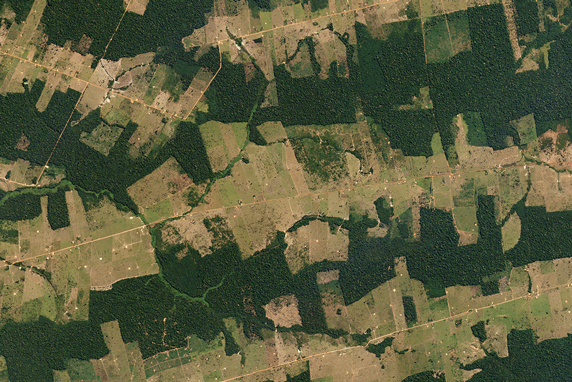
The spread of many infectious diseases from humans to animals can be traced to destruction of forests around the world. Photo courtesy of Planet Labs, Inc. from Wikimedia Commons licensed under CC BY-SA 4.0
“Where there is high biodiversity, as in rainforests and tropical forest areas, you have more potential pathogens. This is the habitat that wild animals need to survive most in. They need big areas to find a constant source of food,” says Raina Plowright, a bat specialist at the Bozeman disease ecology lab at Montana State University. “What we are doing, though, is destroying the natural world, constantly chipping away at wildlife habitats, bringing animals into situations where they have to interfere with humans via road building or the wild meat trade. We suspect that when you put animals in situations where they have to eke out resources in a human situation you get diseases. The trouble is, we don’t know what else is out there and [have] no idea what is going on in many parts of the world.”
Plowright has studied how bats, which are the known reservoir hosts of viruses like Nipah, Hendra and possibly Ebola, have been forced by the fragmentation of their habitats to find new places to live and increase their dependence on humans.
The nightmare scenario of a new, even more dangerous virus haunts her. “Could there be another virus with the same devastating features as COVID-19 but with a much higher fatality rate?” she asks. “Who really knows what diversity of features lives in viruses in nature?”
“We are playing a Ponzi scheme with the ecosystems that allow our planet to survive.” – Raina Plowright“We need a global pandemic policy. Ecological security needs to become one of the tenets of biosecurity. I would work urgently to preserve continuous landscapes of habitat for wild animals and do everything we can to limit our encroachment on what is left,” she says.
“We are playing a Ponzi scheme with the ecosystems that allow our planet to survive. We know what needs to be done to move towards more sustainable food systems that do not regularly spill out novel diseases and lead to an ever-increasing prevalence of non-communicable disease. All we lack is the political commitment,” she says.
The Way We Farm
Contact with wild animals is not the only way zoonotic diseases move to humans. As MERS demonstrated, livestock can be a problem, too. Salmonella, smallpox and measles are all thought to have originated with domesticated animals. And today, with more intensified farming, the problem is even worse.
“Camels used to be kept free range. They have become very valuable in the Middle East with oil money, but instead of being farmed free range … they were put in sheds,” Randolph says. “Lots of camels together lead to more contact between them and more camel-to-human contact. When you change a farming system, you run risks.”
The industrial way we farm today is leading to new and dangerous pathogens emerging, says Eric Fevre, chair of veterinary infectious diseases at the University of Liverpool. “There is some thought at present that even if COVID-19 originally came from a bat, it may have amplified in some high intensity farming system before jumping in to humans.”
“As we select for better milk cows, better beef cows or better egg-laying chickens, we create populations of animals that often live in intensive conditions but where the genetics are very similar,” he says. “And that creates risks for emergence of diseases, because if these genetically uniform large populations are susceptible, things can spread very quickly.”
The 1998 outbreak of Nipah, a henipavirus with a 40–75% fatality rate occurred when flying foxes, which are among the largest bats in the world, were deprived of their usual food and moved close to industrial pig farms set in fruit orchards in Thailand. The pigs that consumed the bats’ half-eaten, disease-ridden fruit showed few symptoms but passed the virus on to humans. Millions of pigs were destroyed, over 200 people have so far died, and the disease has been found in Bangladesh and India.
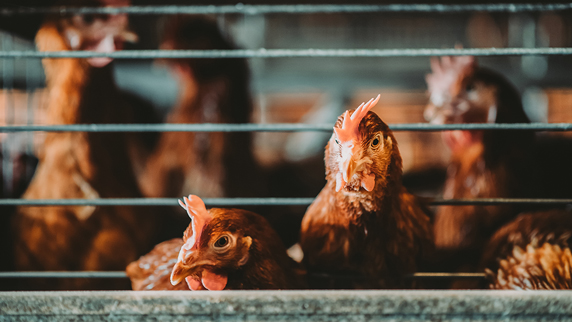
Intensively farmed poultry and other farm animals have been implicated in the spread of a variety of zoonotic diseases. Photos © iStockphoto.com/Marcus Chung
The Asian H5N1 virus originating in poultry farms and sporadically infecting humans has so far killed over 450 people, more than half those infected. Intensive pig farming is thought to have led to the H1N1 “swine flu” pandemic of 2009–10 that swept around the world, killing an estimated 151,000–575,000 people in a single year.
Jonathan Quick, a faculty member at Harvard Medical School who authored of The End of Epidemics and now also works as managing director of pandemic response, preparedness and prevention at the Rockefeller Foundation, argues that as agriculture expanded into pristine forests and meat production became increasingly industrialized, these farms became the “likely route” for future zoonotic pandemics.
Factory farming is especially prone to the emergence of dangerous pathogens, he says. “Hundreds of thousands of people are dying every year because of antibiotics [that] are not working. It’s a slow-motion pandemic. It’s real and remains an issue. Equally, avian and swine flu are still part of the genetic roulette [we are playing].”
Intensive farming of wildlife, especially in Southeast Asia and China, concerns experts as well. Instead of farming a small range of animals like cattle, sheep, goats, poultry and pigs — to whose diseases humans have over centuries become partly immune — farmers are now breeding hundreds of different animals for both food and medicine with potential risk of pandemics. One U.N. Food and Agriculture Organisation study in Vietnam found 185 animal species being farmed, including ostriches, fruit bats, crocodiles, porcupines, flying foxes, turtles, crab-eating macaque monkeys, grasscutters, green pythons, civets, wildcats, deer, snakes and multiple rodents.
Veterinarians and epidemiologists argue that an important way to reduce the risk of future pandemics is to farm more sustainably. “From a viral emergence perspective, farmed animals are likely a lower risk than wild-caught animals. However, given the size of the wildlife farming industry in China, routine disease surveillance and veterinary care at farms and in transport to markets would need to be improved,” writes Peter Daszak, president of the EcoHealth Alliance, in a paper published in March at Biosafety and Health.
Veterinarians and epidemiologists argue that an important way to reduce the risk of future pandemics is to farm more sustainably.
“We need to shift away from an ambulance-style, doctor-driven, reactive response to the pandemics that predictably appear and towards a proactive response that will build safe food systems. We are losing too many species, too many natural landscapes. We are intensifying agriculture in ways that are inhumane and unsustainable. The rich turn a blind eye, the poor bear the brunt of unsustainable systems,” Randolph says. “This is a time of reckoning, of hard choices and new directions. Things that cannot go on forever will stop — often abruptly and nastily.”
Urban Connection
Deadly diseases are also increasingly likely to spread from animals to humans in fast-growing cities where animals and humans are crowded together.
As people have migrated in from rural areas, the peri-urban areas that surround most cities in developing countries have become densely populated with people and animals. “Many people keep goats, chickens there. Shallow wells get contaminated by the animals, there’s no sanitation, waste collects and illness spreads quickly. People have very little money,” says Diana Mitlin, principal researcher for human settlements with the International Institute for Environment and Development.
Urbanization is likely to lead to greater populations of urban wildlife like rats, foxes, skunks and possums, says Jamie Bartram, former head of the water, sanitation, hygiene and health at the WHO, now a professor of civil engineering at the University of Leeds and of public health at the University of North Carolina at Chapel Hill.
It is poor sanitation and water that spreads disease around densely packed cities, says Bartram. “Water is important because it moves pathogens around between individual animals, between species and from animals to humans. Waterborne zoonotic pathogens cause both gastrointestinal diseases like diarrhea and other illnesses like leptospirosis and hepatitis. But it is likely that some, possibly many, remain unrecognized,” says Bartram.

More than 320 people were infected and dozens when vermin spread SARS through the Amoy Gardens apartment complex in Hong Kong in 2002. Photo courtesy of WMwiki from Wikimedia Commons licensed under CC BY 3.0
One of the worst recent zoonotic incidents emerged in China, probably after a person became infected by a previously unknown coronavirus pathogen on a chicken farm in 2002. After the virus, which we now know as SARS, traveled to Hong Kong in an ill man, rats and cockroaches spread it through the drains and plumbing system of a dense cluster of 19 apartment blocks called Amoy Gardens. More than 320 people were infected, and 33 died before it was brought under control.
SARS threatened to spread around the world but in the end traveled to only 29 countries, killing 774 people. “The world really dodged a bullet with SARS, and because the experience was not that bad for large swathes of the world, we failed to learn our lessons from it. It was an alarm call we all slept through,” says Bartram.
SARS shows how fragile our cities are and how exposed people can be to virulent pandemic disease, he says. “We ignore Amoy Gardens cluster for SARS at our peril. Underneath our cities are drainage and water systems which through rivers connect one city to the next and to food chains. A disease transmitted through water would be a big deal but would likely be localized. But a disease that was contagious, transmitted from person to person and which could survive in the environment to be transmitted through water would be a major challenge,” he adds.
The way to reduce risk, he says, is to invest in accessible safe water and toilets for all.
“A no-regrets investment would be to ensure every household, hospital, school, marketplace, transport hub and workplace had this. It would pay itself back in health and productivity. At present, high-income countries are restricting these, and low- and middle-income countries have not yet attained them,” he says.
Pet Problems
The explosion in the number of pets and companion animals that now share their lives with humans also threatens to spread disease in new areas. In the U.S. alone, it is calculated that around two in three households own a pet, and increasingly these are not just cats and dogs, but snakes, rats, hamsters, guinea pigs, rodents, hedgehogs, chinchillas, birds and ferrets. The result is potentially serious epidemics.
Bruno Chomel, a professor of veterinary medicine at the University of California, Davis, says affluence is leading to larger pet populations and possibly new diseases.
“The exponential growth of human population is leading to more incursions in natural habitats and exposure to pathogens naturally infecting wildlife. Our domesticated animals then can be a relay for some of these pathogens, such as flying foxes for Nipah virus and horses for Hendra. In some Middle East countries, it has become trendy to have exotic carnivores as pets. Movies such as Jurassic Park have led to an increase in the ownership of reptiles like iguanas in lieu of dinosaurs and can easily spread salmonella. Most reptiles are natural carriers of Salmonella bacteria,” he wrote in an email.
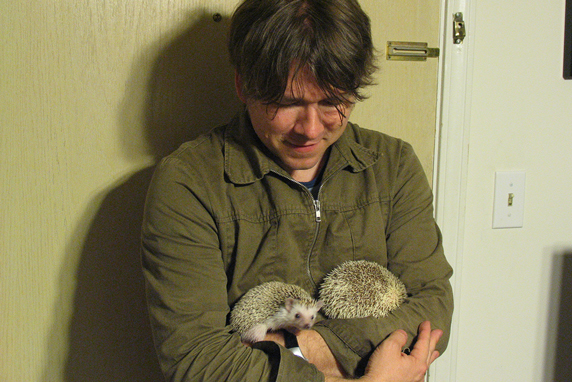
Exotic pets such as pygmy hedgehogs may be cute, but they also can transmit a variety of diseases to their owners and others. Photo courtesy of Leigh Kelsey from Flickr licensed under CC BY-NC-ND 2.0
Reports suggest that diseases like meningitis, monkeypox and Chagas disease have at times been transmitted to humans from people getting too close to their pets. Severe monkeypox in humans has been linked to pet prairie dogs, lyssaviruses to pet bats, ringworm infections from African pygmy hedgehogs or chinchillas. Meanwhile, birds, reptiles and rodents carry salmonella, and hamsters can carry a virus that can cause nervous system disease.
“So far there have been no major epidemic or pandemic starting in the home. But there have been large outbreaks with hundreds of human cases … for salmonella and reptiles or rodents, tularemia and pet prairie dogs, lymphochoriomeningitis virus and golden hamsters, Psittacosis and exotic birds or pigeons,” says Chomel.
As far as solutions, go, “surveillance is the key,” Chomel says. “It is time to stop building walls between human health and animal health, environment and ecology. It should be mandatory to have veterinary public health units within departments of health to have a better grasp on zoonotic pathogens, especially emerging ones from farm animals and pets, and to regulate the wildlife trade and bushmeat markets.”
Human Error
Human error, even in high-security laboratories that handle the most dangerous pathogens, must be taken seriously when assessing potential future pandemics, says Filippa Lentzos, a biosecurity expert in the departments of War Studies and of Global Health & Social Medicine at King’s College London.
“Lab design cannot overcome human error or poor training. It’s fairly rare to have accidents, but they happen all the time. They can result from a laboratory culture or an individual. Most researchers are working with pathogens with low epidemic potential, so there is no great risk. But others are highly dangerous,” she says.
“In the U.K., accidents have resulted in the releases of smallpox and foot and mouth disease,” she says. “In the U.S., various viruses like Ebola and bird flu were found to have escaped CDC laboratories.”
Human error, even in high-security laboratories that handle the most dangerous pathogens, must be taken seriously when assessing potential future pandemics.Marburg virus disease was named after German lab workers were exposed to a virus from monkeys shipped from Uganda, and accidents in Russian and Chinese laboratories were implicated in the reemergence of deadly H1N1 flu in 1977. Secret military facilities also pose a risk.
“Lab incidents … can lead to the release of disease into the community outside the lab; lab workers with such infections will leave work carrying the pathogen with them. If the agent involved were a potential pandemic pathogen, such a community release could lead to a worldwide pandemic with many fatalities,” wrote Lynn Klotz, a senior science fellow at the U.S. Center for Arms Control and Non-Proliferation in an article for the Bulletin of Atomic Scientists.
Strategies to reduce risk include ensuring standard safety practices are followed, “including lab waste disposal practices and infection reporting,” Lentzos says. “I’d also be concerned about lapses related to risk assessments, where principal investigators make judgments about the risks involved in carrying out particular research experiments.”
Ultimate Solution: Vigilance
In all instances, Quick says, investments in public health systems are critical. “All epidemics arise from weak health systems,” he wrote in a 2016 blog post. “We can have all the medications and knowledge available to heal the sick, but if we don’t build strong health systems we will continue to see … epidemics cause needless suffering and death, while crushing economies. We can enable people and countries to thrive, or continue to lurch from one public health crisis to another instead of stopping them all.”
Four years later, as the novel coronavirus spreads around the world, he says: “The single most important thing is actually the most low-tech. We have to get [the] front line of health care all over the world listened to by the next level up. With COVID-19, the next level up was in denial. To avoid pandemics, it needs vigilance all the way up and then rapid action.”
Related Posts
Ensia shares solutions-focused stories free of charge through our online magazine and partner media. That means audiences around the world have ready access to stories that can — and do — help them shape a better future. If you value our work, please show your support today.
Yes, I'll support Ensia!